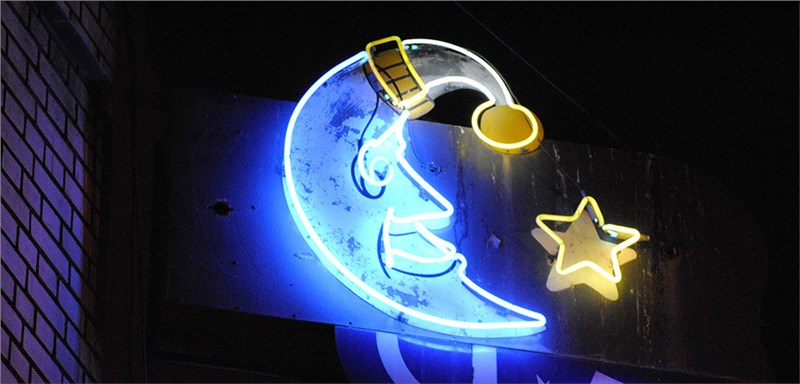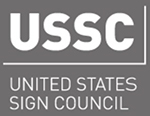From Signweb.com
To appropriate a Mark Twain quote, rumors of neon’s death have been greatly exaggerated. Granted, it’s
unrealistic to expect its widespread return to illuminating enclosed channel letters or to brightening cabinet signs when LEDs or fluorescent tubing do so far more economically.
elements, no alternative matches neon’s luminance. And, neon possesses an intangible, yet
undeniable, appeal – its legacy as the luminescent catalyst of vibrant urban areas worldwide resonates today. Over the late 20th and early 21st centuries, complex economic forces have undone many cities’ vitality. Of course, a withering business climate also translates into a desolate signage landscape. Now, leaders in many US metropolitan areas look toward their urban cores for entrepreneurial rejuvenation. Often, these business owners are interested in celebrating local culture with their signage. Enter neon.
Whether the customer’s goal is to be historically reverent, funky or simply bright, neon brilliantly
fulfills branding needs. Neon sign shops keep neon front and center in the public eye, as does a gallery
from an architectural-neon relighting along Route 66. Neon was omnipresent during the Mother Road’s heyday, so they two share an intertwined, iconic history.
supplies, and lighting tradeshows underscore that only the wares of new-generation manufacturers
are being touted. Still, demand for neon remains
strong in the marketplace, and shops who ply their
trade with it have remained resourceful. And, as this gallery attests, they provide abundant local color. In 1986, founders Greg and Sharon Keshishian
synergized their glassblowing and metalworking talents and founded Austin, TX-based Ion Art, a
multi-faceted company that builds signage, sculptures and illuminated architectural graphics.
Contrary to some shops’ tendencies to narrow production capacity and outsource complex work,
the shop eagerly embraces challenges and builds all elements in-house. Mark Westphal, Ion Art’s lead
fabricator, said, “Austin is more inclined to embrace newer styles of neon as a modern-retro aesthetic
than actual preservation of old elements.”
To accomplish intricate neon bends, Sharon said, “Always use gravity in your favor while bending,
allowing it to do your work for you. You can’t fight gravity or your glass. You also need good fires and a
flat table.”
To appropriate a Mark Twain quote, rumors of neon’s death have been greatly exaggerated. Granted, it’s
unrealistic to expect its widespread return to illuminating enclosed channel letters or to brightening cabinet signs when LEDs or fluorescent tubing do so far more economically.

elements, no alternative matches neon’s luminance. And, neon possesses an intangible, yet
undeniable, appeal – its legacy as the luminescent catalyst of vibrant urban areas worldwide resonates today. Over the late 20th and early 21st centuries, complex economic forces have undone many cities’ vitality. Of course, a withering business climate also translates into a desolate signage landscape. Now, leaders in many US metropolitan areas look toward their urban cores for entrepreneurial rejuvenation. Often, these business owners are interested in celebrating local culture with their signage. Enter neon.
Whether the customer’s goal is to be historically reverent, funky or simply bright, neon brilliantly
fulfills branding needs. Neon sign shops keep neon front and center in the public eye, as does a gallery
from an architectural-neon relighting along Route 66. Neon was omnipresent during the Mother Road’s heyday, so they two share an intertwined, iconic history.

supplies, and lighting tradeshows underscore that only the wares of new-generation manufacturers
are being touted. Still, demand for neon remains
strong in the marketplace, and shops who ply their
trade with it have remained resourceful. And, as this gallery attests, they provide abundant local color. In 1986, founders Greg and Sharon Keshishian
synergized their glassblowing and metalworking talents and founded Austin, TX-based Ion Art, a
multi-faceted company that builds signage, sculptures and illuminated architectural graphics.
Contrary to some shops’ tendencies to narrow production capacity and outsource complex work,
the shop eagerly embraces challenges and builds all elements in-house. Mark Westphal, Ion Art’s lead
fabricator, said, “Austin is more inclined to embrace newer styles of neon as a modern-retro aesthetic
than actual preservation of old elements.”
To accomplish intricate neon bends, Sharon said, “Always use gravity in your favor while bending,
allowing it to do your work for you. You can’t fight gravity or your glass. You also need good fires and a
flat table.”
Tags
Subscribe to Parvin-Clauss's Blog






Comments